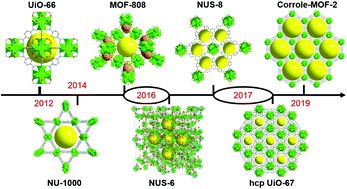The chemistry and applications of hafnium and cerium(iv) metal–organic frameworks
Abstract
The coordination connection of organic linkers to the metal clusters leads to the formation of metal–organic frameworks (MOFs), where the metal clusters and ligands are spatially entangled in a periodic manner. The immense availability of tuneable ligands of different length and functionalities gives rise to robust molecular porosity ranging from several angstroms to nanometres. Among the large family of MOFs, hafnium (Hf) based MOFs have been demonstrated to be highly promising for practical applications due to their unique and outstanding characteristics such as chemical, thermal, and mechanical stability, and acidic nature. Since the report of UiO-66(Hf) and DUT-51(Hf) in 2012, less than 200 Hf-MOFs (ca. 50 types of structures) have been reported. Besides, tetravalent cerium [Ce(IV)] has been proven to be capable of forming similar topological MOF structures to Zr and Hf since its first discovery in 2015. So far, ca. 40 Ce(IV) MOFs with 60% having UiO-66-type structure have been reported. This review will offer a holistic summary of the chemistry, uniqueness, synthesis, and applications of Hf/Ce(IV)-MOFs with a focus on presenting the development in the Hf/Ce(IV)-clusters, topologies, ligand structures, synthetic strategies, and practical applications of Hf/Ce(IV)-MOFs. In the end, we will present the research outlook for the development of Hf/Ce(IV)-MOFs in the future, including fundamental design of Hf/Ce(IV)-clusters, defect engineering, and various applications including membrane development, diversified types of catalytic reactions, irradiation absorption in nuclear waste treatment, water production and wastewater treatment, etc. We will also present the emerging computational approaches coupled with machine-learning algorithms that can be applied in screening Hf and Ce(IV) based MOF structures and identifying the best-performing MOFs for tailor-made applications in future practice.



 Please wait while we load your content...
Please wait while we load your content...